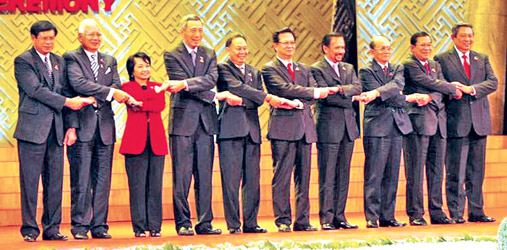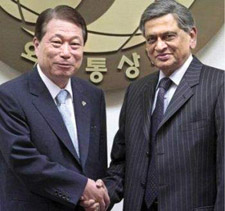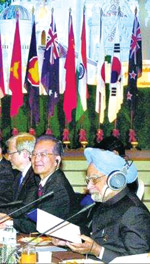Rising status
As countries in East Asia begin courting India, the possible
formation of an ASEAN+8 might give it a larger strategic space
P S SURYANARAYANA
Are China’s neighbours wooing India over larger issues of global
importance? Is China also keen on cooperating with India over a specific
regional issue as different from the global development concerns?
|

The ASEAN flags |

The ASEAN leaders |
Answers to such questions are not easy to foresee beyond the details
of available political and diplomatic signals. The overall diplomatic
and economic environment in the geopolitical region called East Asia may
also change, producing new strategic consequences for the major players.
Within such limitations of informed futurology, it is clear that
India is being courted and also being given some benefit of the doubt on
issues such as civil nuclear energy, to mention just one.
Four current developments are the real stuff of such an emerging
scenario. First, the new Japanese Prime Minister, Naoto Kan, has
initiated genuine talks with India for cooperation in the area of civil
nuclear energy.
Shorn of the diplomatic nicety of language as is evident in the term
cooperation, it is obvious that India will be the greater beneficiary of
any agreement that may be reached.
Secondly, South Korean President Lee Myung-bak has evinced interest
in India’s space-faring capabilities as a potential platform for his
country’s progress in this domain. More importantly, though, he is keen
that South Korea must enter into a civil nuclear agreement with India,
which in turn can buy hardware such as reactors from Korea.
The third but no less significant factor is evident as a non-official
signal, distinct from an authoritative move, from China. The interesting
development relates to a considered call for thinking the unthinkable.
It has been suggested by Wu Jianmin, a senior adviser to the Chinese
Foreign Ministry and a former career diplomat, that China and India
could think of a concerted initiative to ensure the stability of
Pakistan.
|

External Affairs Minister S.M. Krishna with his South Korean
counterpart Yu Myung-hwan during their meeting at the Foreign
Ministry in Seoul on June 18. India and South Korea held their
annual cooperation talks after their leaders agreed to expand
bilateral relations beyond trade and economic ties to encompass
cooperation in security and other matters. |
While this informal proposal requires much dressing up, in a positive
diplomatic sense such bold new thinking is the stuff of futuristic
regionalism.
ASEAN+8 grouping
The fourth but not the least turn of uncoordinated events in East
Asia, with immediate relevance to India, applies to several other
countries as well. The Association of Southeast Asian Nations has
initiated a new move for the possible formation of an ASEAN+8 grouping.
As more than just a straw in the local wind, ASEAN’s latest essay, if
it fructifies, will suitably bring the United States and Russia onto the
regional scene. They will then be new partners of the existing
leaders-driven entity called the East Asia Summit (EAS). The ASEAN+8
grouping itself may either supplant or coexist with the EAS.
The EAS comprises all the 10 ASEAN member-states as also China,
Japan, South Korea, India, Australia and New Zealand. Given this fact,
the idea of an ASEAN+8 is not a bonus for India for its East Asian
diplomacy.
However, any such new forum, if it takes shape as an institution with
some potential longevity, will be particularly useful to Official India,
given its current predilection for partnership with the US.
In this sub-context, another factor favouring New Delhi is its
continuing good engagement with Moscow. This aspect is not at all
insignificant although the current India-Russia engagement is not the
same as New Delhi’s earlier equation with Soviet-era Kremlin.
On balance, in such a wide perspective, an ASEAN+8 grouping might
give India a larger strategic space in East Asia, albeit in the company
of the U.S. and Russia. To this extent, and if this group does take off,
China may not overshadow India in an ASEAN+8 setting, unlike in the
current EAS network.
For several years now, China has been engaged in transforming its
extensive historical links with some South-East Asian countries in order
to create suitable postmodern ties for mutual benefit. India does lag
behind China in such an endeavour, and it is this aspect that accounts
for the current balance of forces within the EAS forum.
Also relevant to this configuration, generally seen to be favourable
to Beijing, is the predilection of Australia and a number of ASEAN
countries to be mindful of the dynamics of China’s relentless rise as a
potential or possible global superpower.
In a broad sweep, the China-sensitive countries in the EAS forum
include India and Japan as well. Yet, in a narrow sense of realpolitik
considerations, Tokyo and New Delhi do not actually figure in the
category of EAS players with a pro-China tilt. By contrast, several EAS
members are generally seen to be wary of any potential or possible US
adventurism on matters of vital interest to China.
Such interplay of forces in a multilateral setting like that of the
EAS or the potential ASEAN+8 grouping does make for romanticized parlour
games of the political kind. However, major powers, both established
players and rising nations, do not necessarily count on the multilateral
process for resolving their key disputes.
A major power often prefers to settle its differences through a
bilateral process. Any exception to this general practice is just that.
Also self-evident is the ground reality that major powers tend to derive
greater benefits from the bilateral process than the multilateral
approach.
In this sense, New Delhi’s new opportunities in its bilateral
interactions with Japan or South Korea or China constitute the real
stuff of India’s own version of peaceful rise insofar as the East Asian
scene is concerned.
|

Prime Minister Manmohan Singh and, to his right, Chinese Premier
Wen Jiabao at the 4th East Asia Summit in Hua Hin, Thailand, on
October 25, 2009. China may not overshadow India in an ASEAN+8
setting, unlike in the EAS network. |
Interestingly, an oft-asked question across this region is, Why
should China’s rise cause ‘concern’ to the rest of the world while
India’s ascent does not.
The answers, of course, depend on the varied standpoints of
individual countries. The commonly heard argument is that India’s
policies and practices are far more ‘transparent’ than those of China.
The mystique of Beijing’s short but studied comments is often
mistaken for a mystery.
It is with a ‘transparent’ India that Japan has now decided to
negotiate a civil nuclear pact. The first round of parleys was held in
Tokyo on June 29 and 30. Japan saw those talks as a “constructive”
beginning and left the door open for an incremental engagement over this
issue. These formal talks were preceded by what Japan described as
pre-negotiation ‘consultations’.
Sensitive domain
A top Japanese official, Kazuo Kodama, privy to the meeting that Kan
held with Prime Minister Manmohan Singh in Toronto before the June-end
Tokyo talks, later told this correspondent that the two leaders evinced
interest in moving forward in this sensitive domain.
Kodama quoted Kan as telling Manmohan Singh that “there exists a
large potential for Japan to cooperate in the area of India’s peaceful
use of nuclear energy”.
- The Frontline |



